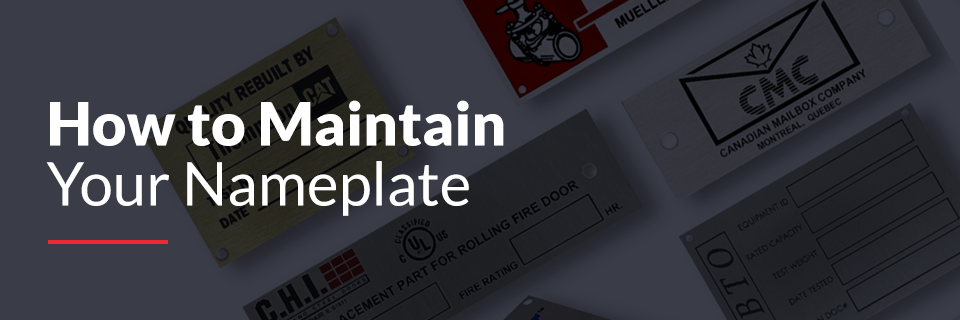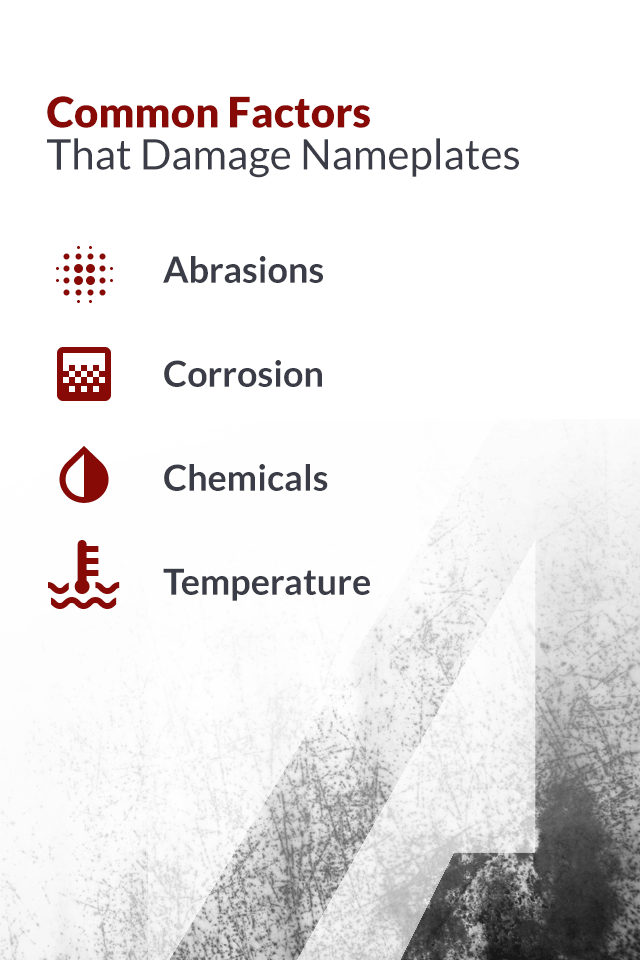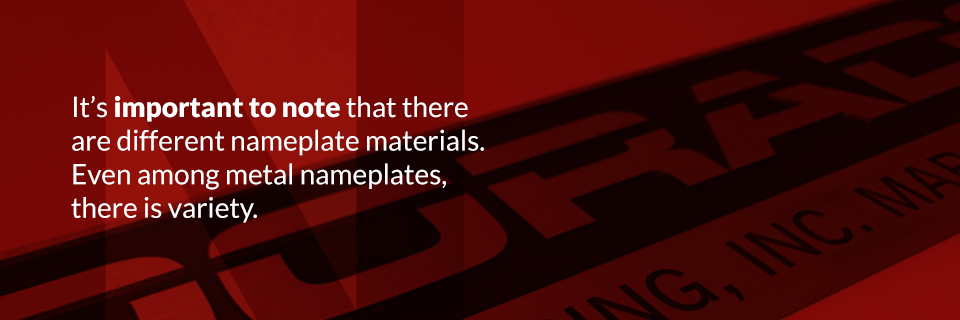How to Maintain Your Nameplate

Your nameplate is an essential facet of your office. It helps identify you, guides visitors to your office and can even be quite beautiful. More than that, however, it says a lot about you. If your nameplate is neat and clean, this immediately presents you as someone who dedicates themselves to everything they do with the utmost care and attention. A nameplate that’s grimy, damaged or in any state of disrepair, however, leads people to make the opposite assumption about you. It might suggest you show the same level of inattention to both your work and your nameplate.
Impressions can be powerful. To help your visitors form the right ones, it’s essential that you keep your nameplate looking clean and fresh. Of course, this is no easy feat when there are so many different ways it can get damaged. Accidents happen to all of us, and your nameplate will inevitably show wear after a few years.
When this happens, there’s no need to worry. Today, we want to step you through some of the most common types of nameplate damage, as well as the top ways to combat them and repair any harm that may have come to your nameplate. Once you learn how to maintain nameplates like this, you’ll be ready to make the right impression for years to come.
Common Factors That Damage Nameplates
Cleaning would be easy if all damage were the same. But of course, it’s never quite that simple. Instead, many different outside forces can cause severe damage to your nameplate, given enough time. All of them require different methods of treatment and prevention, and as such, we should consider them all separately.
With this in mind, here are some of the top causes of nameplate damage as well as a few corresponding metal nameplate restoration and maintenance tips.
1. Abrasions
An abrasion is just a fancy name for a scratch, scrape or some other type of contact surface damage that might mar the smooth finish of your metal nameplate. It might happen if you drop your nameplate on the floor, or perhaps if a heavy object crashes into it. Either way, this might look like a crack, a scar or a scratch. Because nameplates see a lot of handling, they’re quite susceptible to this type of damage.
The problems with this type of damage are twofold. Firstly, they’re unpleasant to look at. They cause a scar right across the plate and detract from the simple attractiveness of the plate. Secondly, and arguably more seriously, these abrasions can obscure your name, making it difficult or impossible to read.
While there are some treatment methods once an abrasion has occurred, the best way to fix this problem is to avoid it in the first place. Search for specifically abrasion-resistant metal for your nameplate and see if this doesn’t prevent this type of damage before it happens.
2. Corrosion
We’re all likely familiar with corrosion in a passing sense. This is a term for the gradual breakdown of metals through natural chemical reactions with their environment. In other words, corrosion is when moisture, dirt or some other chemical contacts the metal and sits on its surface, slowly eating away at the finish.
If the air in your facility is hot and moist, corrosion will almost certainly occur at a faster rate. If water contacts your nameplate, this will also speed corrosion. Salt, saltwater, and bacteria can all also hasten the spread of corrosion, damaging both the beauty and legibility of your nameplate.
Because corrosion is a product of the environment in which your nameplate exists, the best way to curtail this damage is to control that environment. If your nameplate is going to be exposed to saltwater, or road salt, clean your nameplate regularly to wipe away the dirt and bacteria that may be collecting there. Finally, if you have any control over the climate of your facility, try for a medium temperature with low humidity, as these conditions help slow or halt the spread of corrosion.
3. Chemicals
Yes, some chemicals are responsible for corrosion, but there is also a whole host of other substances out there that can cause a variety of different types of damage to your nameplate. Depending on which chemicals are likely to be prevalent in your building and industry, it might be worth investing in a material that’s designed to be resistant to those chemicals.
Just a few of the chemicals to be aware of are those found in materials such as gasoline, alcohol, and acetone. These chemicals and others may be responsible for ruining printed labels, causing adhesion problems, removing ink, and generally causing plates to become unreadable.
First, you can avoid this damage by investing in the correct metal for your nameplates. If you know you’ll constantly be around acetone, for example, it’s worth finding a metal designed to resist the chemicals contained therein. Otherwise, take care to clean your nameplate regularly, giving it particular attention after you know it’s been splashed or coated in some foreign substance.
4. Temperature
Temperature is the final of the four most common causes of damage to your nameplate. Any type of extreme temperature, whether at the hot or cold end of the spectrum, it’s important to bring these conditions up to our nameplate specialists to help determine the best material or adhesive for your use.
Interestingly enough, both extreme heat and extreme cold lead to the same primary problem — lack of adhesion. In low temperatures, the wrong adhesive materials will shrink, gaining a brittle quality and losing their stickiness. High temperatures, on the other hand, cause materials to soften and droop, resulting in a loss of adhesion. Additionally, high temperature can cause poor material chosen nameplates to fade and images to become distorted.
The best way to prevent this damage before it happens is to bring your facility’s extreme conditions to our attention prior to production altogether. Maintain your facility temperature at a comfortable mid-range, and avoid exposing your nameplate to any heaters or freezers. If this type of exposure is unavoidable, you may need to look into nameplates specifically designed to resist these conditions.

Methods to Clean Your Nameplate
We’ve referred to the process of cleaning metal nameplates several times now. It’s essential, since it helps get rid of any chemicals, dirt or bacteria that may have found their way onto your nameplate. By cleaning them off, you stop the damage before it even has the opportunity to happen.
Of course, it’s one thing to talk about the importance of all the ways to maintain metal nameplates, and another thing to do it. To help you figure out how to keep your plate clean and tidy, we’ve got a list of metal nameplate cleaning tips. Try these out and see if your nameplate doesn’t look a little brighter and cleaner.
How to Wash Your Nameplate
It’s important to note that there are different nameplate materials. Even among metal nameplates, there is variety. Some may be stainless steel, while others are aluminum. In light of this, let’s examine how to clean each type separately.

1. Aluminum Nameplate Cleaning Tips
Aluminum is a common nameplate material, firstly because the metal itself is so affordable, but also because it naturally resists tarnishing and corrosion, which makes it highly durable.
To clean aluminum, try using a clean rag and warm water. With the damp rag, gently rub at the surface of the plate, making sure to work the cloth into any nooks and crannies. If the dirt is stubborn and resists this gentle cleaning, don’t be afraid to attack it with a little more force. Add a mild soap to the cloth and continue rubbing with the damp cloth. Once you’re finished washing, be sure to dry and buff the plate with a final pass from a soft, dry cloth. Be sure this cloth is gentle, to prevent it from causing scratches.
2. Stainless Steel Nameplate Cleaning Tips
Another common choice for metal nameplates, stainless steel isn’t quite as inexpensive, but it offers the bonus of being exceptionally durable in caustic and acidic environments that might damage other metals. Additionally, stainless steel resists corrosion, intrusive chemicals and high levels of heat, as well as dents and abrasions. All these factors work together to create an impressive resume for the stainless steel plate, making it great for a variety of working environments that might be hazardous to other metals.
Despite all these qualifications, however, stainless steel isn’t invulnerable to damage. When the time comes to give your stainless steel plate a cleaning, we recommend a solution of warm water and a gentle detergent. Use a cloth to rub this into the plate, and the soap should help cut through any grease marks, dirt or grime that have collected on the surface. Having completed this step, next use a dry cloth — cotton or any other soft material should do the trick — to wipe off any excess moisture. Remember, standing water will damage your plate.

3. Special Cleaning Tips for Etched Plates
Etched plates are the same as ordinary metal nameplates in that they’re made of a metal such as aluminum or stainless, steel and need the same approach to cleaning. What makes them different, however, is that they have letters and characters etched directly into the metal, which creates a whole world of crevices and nooks for dirt, bacteria, and grease to hide in. Worse, these crevices are almost impossible to clean thoroughly, as a surface wipe-down will almost never be sufficient.
The good news, however, is that there is a method to clean engraved metal nameplates.
Begin by using a dry, soft rag to give the surface of the plate a general wipe down. This step won’t touch the etchings, but it will help get the surface clean of any clinging dirt or grime. Next, you’ll want to mix a solution of gentle dish soap with a half-bucket of warm water. This mild soap is ideal for cleaning, as it will be effective at cutting any grease on the plaque’s surface, but not so abrasive that it might scratch the plate.
Soak a soft rag in this soapy solution and use it to wipe down the surface. Then, to get into the crevices of the letters themselves, use a cotton swab. Dip the cotton ends of the swabs into the soapy water and then run the swab down the channels of the letters. Repeat this until the swab comes out clean and there doesn’t appear to be any more dirt in the letters.
Once the letters are clean, be sure to give the surface another once-over to clean away any dirt particles that may have emerged from the cracks of the letters. Give the plaque a final rinse as well, with a rag dipped in clean, warm water. Finally, complete the process by using a soft dry cloth to remove any excess moisture. We recommend grabbing another cotton swab, as well, and using it to dry out the letters.
Learn More About Our Nameplates Today

Perhaps you’ve thought about metal nameplates in the past, but have always been worried about the effort and care in maintaining them. If those have been your concerns in the past, we hope we’ve been able to alleviate some of those worries and convince you metal nameplates are a highly viable solution. With just a little care and attention, these elegant plates can quickly become an attractive addition to any industrial facility.
Ready to get a nameplate of your own? Browse our full selection of metal and etched nameplates today.











1 Comment
Duraslide Pte Ltd
Very interesting, Good job and thanks for sharing such a good information.